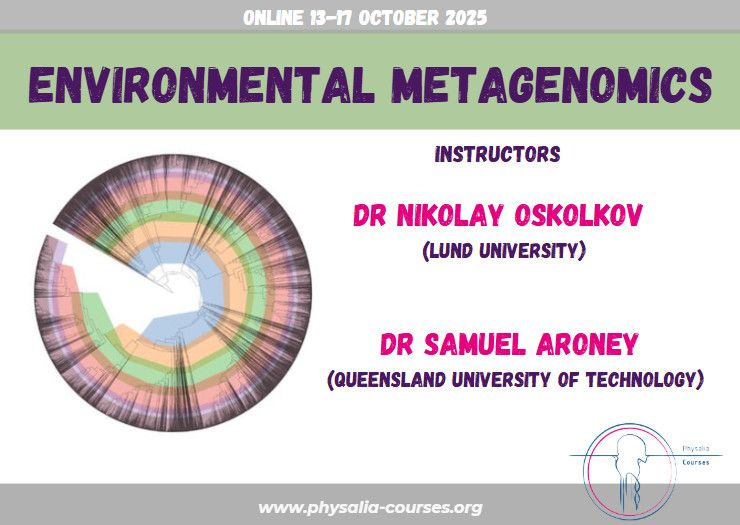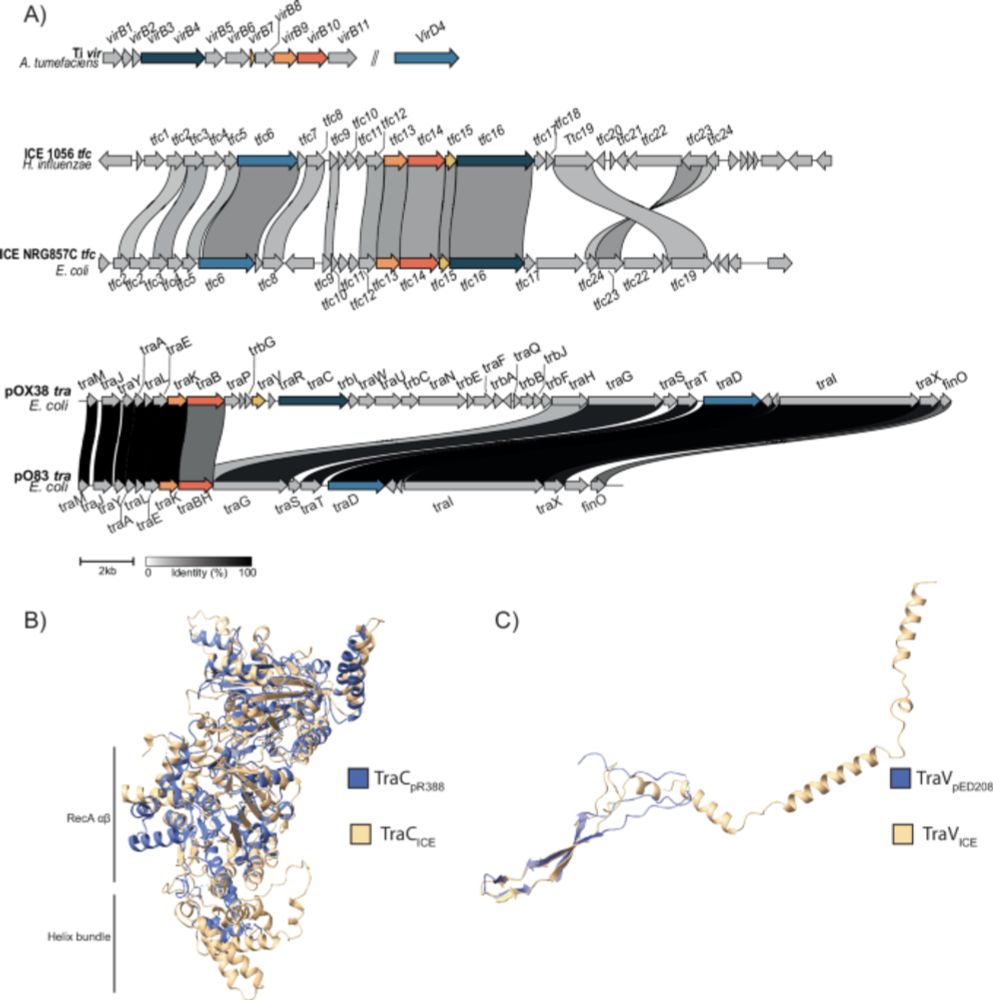
Stellenangebote: Universität Hohenheim
Aktuelle Stellenangebote der Universität Hohenheim.
JOB ALERT! Do you also love large ecological experiments? Become coordinator of our big new geo-biosphere experiment in @terra-cluster.org. 7-year position! Follow link for details.
@gfoesoc.bsky.social
@britishecologicalsociety.org
@ecologicalsociety.bsky.social
@uslter.bsky.social
Please repost!
06.10.2025 16:09 — 👍 15 🔁 26 💬 1 📌 0
I have a fabulous undergrad who has a lot of experience with QIIME2 & using R to analyze microbiome data. She is looking for a job starting in January. Would love to learn more bench and field skills (will be getting some in her last 2 months). Open to academic, industry, government jobs in the US.
06.10.2025 21:34 — 👍 29 🔁 28 💬 1 📌 0

Cryo-EM resolves the structure of the archaeal dsDNA virus HFTV1 from head to tail
This structure of an archaeal tailed virus (arTV) provides detailed insights into arTV assembly and infection mechanisms.
Out in Science Advances: Our #cryoEM structure of HFTV1, a virus infecting the halophile #archaea. *First full atomic structure (containing all structural proteins) of any tailed virus!* Congrats and thanks to all co-authors and our fantastic collaborators! www.science.org/doi/10.1126/...
06.10.2025 11:31 — 👍 113 🔁 45 💬 0 📌 7

Job alert ‼️ UChicago Micro is hiring! Open to tenured/tenure track faculty at all levels in any area of microbiology. Come join our amazing and growing department. apply.interfolio.com/174404
04.10.2025 18:44 — 👍 121 🔁 121 💬 4 📌 1
What are folks using for calling genes these days in isolate genomes: PGAP, Bakta, or Prokka? This is for a 70% GC genome of a very novel lineage.
23.09.2025 16:42 — 👍 10 🔁 7 💬 7 📌 0
Independent research fellowships leading to tenured positions at the John Innes Centre.
Repost = nice. Thank you very much!!!
03.10.2025 16:06 — 👍 45 🔁 79 💬 0 📌 1

DYK most P. aeruginosa carry filamentous phage(s) that don't need to kill the cell to reproduce?
We 👉🏻@nanamikubota.bsky.social show that these Pf phages can go ROGUE.
"Filamentous cheater phages drive bacterial and phage populations to lower fitness"
🔗 authors.elsevier.com/c/1lt5I3QW8S...
02.10.2025 15:55 — 👍 67 🔁 30 💬 6 📌 4

The role of mobile genetic elements in adaptation of the microbiota to the dynamic human gut ecosystem
#CurrOpinMicrobiol from @lgbacteria.bsky.social
www.sciencedirect.com/science/arti...
29.09.2025 11:33 — 👍 27 🔁 12 💬 0 📌 1
Unlocking the genomic repertoire of a cultivated megaphage - npj Viruses
npj Viruses - Unlocking the genomic repertoire of a cultivated megaphage
Multiomic analysis of the only megaphage in culture. In press today.
Unlocking the genomic repertoire of a cultivated megaphage | npj Viruses share.google/HgU1cjRnaHWv...
#phage #bacteriophage
30.09.2025 13:16 — 👍 10 🔁 4 💬 0 📌 0

🚨 Join us for the Environmental Metagenomics course (Oct 13–17, online) with @oskolkov.bsky.social & @aroneys.bsky.social !
🔬 Hands-on training on read-based & assembly-based methods, MAGs, and integrating short & long-read @nanoporetech.com data.
shorturl.at/HOm6X
30.06.2025 13:21 — 👍 10 🔁 6 💬 0 📌 1

Virus and viroid diversity in hops, investigating the German hop virome
Germany is worldwide one of the largest hop (Humulus lupulus L.) producers, an essential crop for the brewing industry. However, infections caused by viruses and viroids can severely impact hop yield and quality. In 2019, citrus bark cracking viroid (CBCVd) – a highly aggressive pathogen in hop – was first reported in Germany, raising concerns about its spread and prompting a broader investigation of the German hop virome.To investigate the viro-diversity in German hops, we started with a pilot study in 2021 targeting three hopyards in the Hallertau region (Bavaria), where CBCVd was previously detected. This study was expanded in 2022 and 2023 to include other main hop growing regions of Tettnang (Baden-Wuerttemberg) and Elbe-Saale (Saxony, Saxony-Anhalt, Thuringia). Leaf samples were collected from hop as well as non-hop plants inside and outside the hopyard, pooled, and proceeded for double-stranded RNAs extraction. High-throughput sequencing (HTS) was used as a diagnostic tool, followed by RT-PCR confirmation. Our analysis identified four viruses infecting hops; hop latent virus (HpLV), hop mosaic virus (HpMV), apple mosaic virus (ApMV), arabis mosaic virus (ArMV) – and two viroids; hop latent viroid (HLVd) and CBCVd. HpLV, HpMV, and HLVd were consistently found across all targeted hopyards, while CBCVd was confined to the Hallertau region. ArMV was only detected in one hopyard at one sampling timepoint. ApMV was the only virus detected in both hop and non-hop plants. Additional analysis of hop pool datasets revealed the presence of other potential hop pathogens, i.e., fungi and bacteria. The results showed a low diversity of viruses and viroids infecting hops. However, this study provides a comprehensive overview on the major viruses and viroids in German hopyards. The results may serve as a useful resource for the development of disease management strategies in hop cultivation and highlight the valuable implementation of HTS in plant pathogen surveillance.
A nationwide #HTS survey of German hopyards identified HpLV, HpMV, ApMV, ArMV and viroids HLVd and CBCVd (CBCVd confined to Hallertau), highlighting HTS as a powerful tool for #PlantPathogenSurveillance and management #PlantViromics 🧬🌾🔬
📄https://doi.org/10.1371/journal.pone.0329289
👤EVBC: Ali Pasha
30.09.2025 13:49 — 👍 5 🔁 2 💬 0 📌 0

Assistant Professor – Global History of Technology - Department of History
University of California, Berkeley is hiring. Apply now!
Job at UC-Berkeley: Asst. Prof. in Global History of Technology, apps due 10/10 (so soon). #history #histSTM #histsci #histphilsci
aprecruit.berkeley.edu/JPF05065
30.09.2025 14:23 — 👍 12 🔁 14 💬 0 📌 3
Just an outrageous amount of structural variation in pennycress. While not yet reproductively isolated, its likely these shredded pericentromeres contribute to some reproductive incompatibilities.
29.09.2025 17:33 — 👍 11 🔁 5 💬 0 📌 0

Delighted to see our paper studying the evolution of plasmids over the last 100 years, now out! Years of work by Adrian Cazares, also Nick Thomson @sangerinstitute.bsky.social - this version much improved over the preprint. Final version should be open access, apols.
Thread 1/n
25.09.2025 21:28 — 👍 299 🔁 153 💬 14 📌 8
Hey all! Now that i've left my position at UQ, I thought I would leverage my network here to see if anyone has leads on environmental genomics, biotech, marine policy positions in the US/Canada/Australia/Europe. I'd love to speak with anyone in those fields re openings, worthwhile recruiters, etc.
25.09.2025 15:09 — 👍 15 🔁 13 💬 1 📌 0

Poster showing the following text: PhD in microbial mechanisms of soil carbon cycling. Soil microbes shape the global carbon cycle in life and death. We study the effect of aboveground land management on belowground soil carbon cycling processes. We aim create a scalable understanding of microbial processes from single cells to populations to communities to ecosystems. Pictures with text: peatland restoration, sustainable agriculture and woodland regeneration.
📢 Funded PhD opportunities for UK candidates in beautiful Edinburgh. Get in touch if you're interested in a PhD on understanding the mechanisms of soil carbon cycling and the role of microbes. We work in different ecosystems: peatlands, forests and agricultural soils. Please repost/spread the word.
16.09.2025 16:25 — 👍 16 🔁 23 💬 0 📌 0

The Mysteries of the Ponderosa Pine
Take a look at the ponderosa pine and the many creatures that rely on it.
So, there you go:
Boring beetles bring blue wood fungus, but butterscotch brings birds that bite the beetles & burning brings more beneficial terpenes.
Now go stick your nose in some sap.
More reading here:
24.09.2025 01:15 — 👍 75 🔁 5 💬 6 📌 1

Faculty Professor Associate - Full-Time | Vaughn Cooper
We are recruiting Faculty microbiologists in three (3) different, complementary, and collaborative areas at the University of Pittsburgh associated with the School of Medicine.
1) Fundamental researc...
🚨 Microbiologists! We are recruiting Assistant / Associate Professors in 3 collaborative areas of our U. Pittsburgh School of Medicine.
1) MMG (my dept): fundamental research in med micro
2) Peds ID / I4Kids institute
3) Center for Vaccine Research
🔗 to all 3 w/info: www.linkedin.com/posts/vaughn...
23.09.2025 22:31 — 👍 93 🔁 127 💬 1 📌 5

A promotional flyer for a webinar in the CSU Bioinformatics Webinar Series. On the left side, it shows the date and time: “26 Sep | 12 PM PST.” It includes instructions to join via Zoom with Meeting ID: 886 2442 3158 and a QR code above. On the right, there is a photo of Dr. Elinne Becket, Associate Professor in the Department of Biological Sciences at California State University San Marcos, sitting outdoors with plants and trees in the background. Below, the title of the talk is displayed: “The Soup that Blue up Twitter.” The description explains that Dr. Becket will discuss the shared curiosity of science, open science, and a story from February 2023 when leftover beef soup prepared by her mom turned bright blue. Scientists and people on Twitter collaborated to investigate, leading to a global effort among microbiologists and chemists. At the bottom, there are links to learn more about upcoming webinars at www.informatics.sdsu.edu and Dr. Becket’s website: https://elinneb.wixsite.com/becketlab
Giving a webinar on #BlueSoup this Friday, in case anyone wants to pop in during their lunch!
22.09.2025 17:55 — 👍 95 🔁 28 💬 10 📌 8
Which is actually mentioned in the paper too 😊 (despite the title maybe giving the other impression).
Also, no matter how much I wish it wasn't true, the same applies to CRISPR spacer hits 🥲
22.09.2025 19:04 — 👍 5 🔁 0 💬 0 📌 0
Just remember kids, proximity ligation can tell you when DNA is in the same cell but not necessarily that a phage successfully replicates on a host
22.09.2025 15:35 — 👍 18 🔁 4 💬 2 📌 0
These findings suggest phage pressure, while present, does not drive C acnes strain fitness on skin.
We propose that physical constraints — such as pore anatomy limiting phage access or skin physiology induced phage-resistant states — may explain the lack of coevolutionary arms race.
22.09.2025 17:57 — 👍 3 🔁 1 💬 1 📌 0
Professor and Chair, Department of Microbiology, University of Chicago. Study the pathogenesis of tuberculosis, and other mycobacterial infections. Opinions my own.
Washington Bureau chief at The Independent, MSNBC Columnist. Author: We’re Not Broken. Tar Heel. He/Him Eric.garcia@the-independent.com
We love bacteria!! Especially Acinetobacter and Bacteroides. The lab is in Dept. of Molecular Microbioloy @WashU in St Louis
PhD in Environmental Microbiology
PostDoc in the MMG at IMEDEA (CSIC-UIB) and at INAGEA (UIB)
Microbial and viral intraspecies diversity & metagenomics
Also exploring RuBisCO gene diversity in extreme cold and hot environments through metagenomics
PhD Candidate (pangenomics + mobile genetic elements + data mining)
Wageningen University & Research
Assistant Professor @ UIowa. Division of Biostatistics and Computational Biology. #microbiome #virome, host-microbial interactions, #dataviz. http://phylotoast.org.
PhD Student at University of Exeter working on using phages to counter antibiotic resistance. Massive archery nerd.
UoE: https://experts.exeter.ac.uk/40015-christian-fitch
Stanford Bioengineering PhD candidate / Biological AI in Brian Hie’s lab at Arc Institute
https://samuelking.cargo.site
Bioinformatician and genomic epidemiologist, deep in the heart of Texas (Houston). Gardening, hiking, and sourdough enthusiast.
PhD student @ Lindell Lab, Technion 🧬
Exploring cyanophage host take-over genes | Microbiology | Phages | Genetic Engineering | Infection Physiology
We are involved in understanding the ecological and evolutionary forces that shape microbial communities in nature.
Visit our website - lifewp.bgu.ac.il/wp/imizrahi/
Twitter - https://x.com/LabMizrahi
Assistant Professor at the University of Toronto in Chemical Engineering and Applied Chemistry. Fascinated by marine microbes and their chemistry. 🌊, she/her, 🌈 https://www.gregorlab.com/
De novo evolved proteins. @bornberglab.bsky.social. he/him.
bornberglab.org/people/eicholt/
Posting the worst medical takes. Have a submission? DM or @ me. #MedSky
Virology enthusiast
Interested in Virus-Host interactions
Researcher at Heidelberg University Hospital
Computational Biologist. Tenure Track Fellow in Health at the University of Liverpool. 🇧🇷🇯🇵🇪🇸🇬🇧🇨🇭
Phylogenomics and Chemometrics. Prog Rock and Post-Punk. C and Python.
@leomrtns@mstdn.science
🔬 Assistant Prof, Pathology @Duke | Director, Clin Micro Lab
🧫 Former Clin Micro Fellow @Memorial Sloan Kettering
👩🏻🔬 Former Postdoc @broadinstitute.org
🎓 PhD @The Rockefeller University
Focus: Diagnostics, AMR, Structural Biology
Geobiology PhD Candidate at Caltech



















